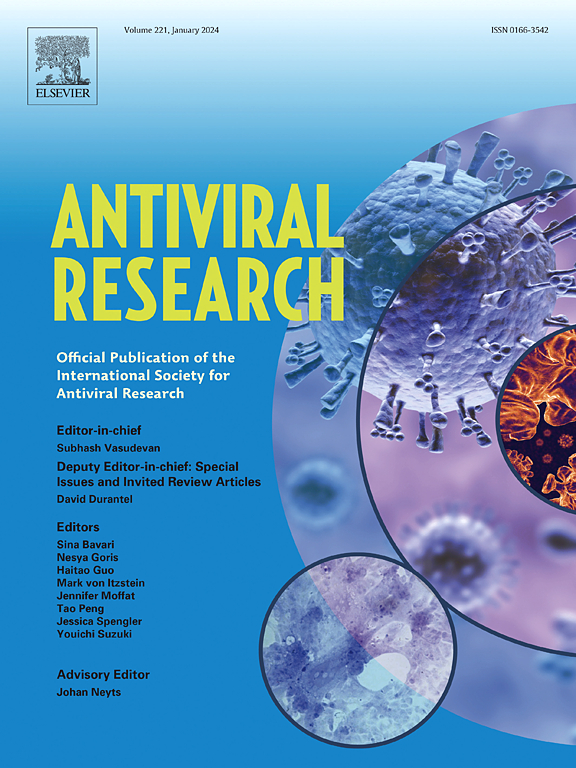RXR agonist S169 inhibits HBV/HDV entry in vitro by disrupting KIF4-dependent NTCP trafficking
IF 4.5
2区 医学
Q1 PHARMACOLOGY & PHARMACY
引用次数: 0
Abstract
Chronic hepatitis B (HBV) and hepatitis D (HDV) viral infections pose serious global health challenges, and the lack of curative therapies calls for the development of new antiviral approaches. Recently, we have identified the Kinesin Family Member 4 (KIF4) as a crucial regulator of the surface transport for NTCP (HBV/HDV entry receptor). Our research has shown that the pan-RXR agonist, Bexarotene, suppresses KIF4 expression and inhibits HBV/HDV infections. However, the clinical use of Bexarotene is limited by poor physicochemical and pharmacokinetic (PK) properties and significant side effects. Here we investigated chemically diverse RXR modulators with tuned activity, and identified the RXR agonist S169 as a novel HBV/HDV entry inhibitor. S169 effectively blocks HBV and HDV infections in primary human hepatocyte (PXB) cultures without evident cytotoxicity. S169's suppressive effect on HBV infection was confirmed by reduction of secreted HBsAg and HBeAg, as well as inhibition of HBV cccDNA, pregenomic RNA, and intracellular HBV DNA. Mechanistically, S169 suppressed FOXM1-mediated KIF4 expression, leading to decreased NTCP surface levels and a marked decrease in HBV preS1 peptide binding to the hepatocyte cell surface. S169 is reported to exhibit enhanced oral bioavailability, favorable PK parameters, lower toxicity compared to Bexarotene. Interestingly, S169 induced a modest inhibition of NTCP-mediated bile acid transport up to 10 μM, which remained unchanged at higher concentrations. Furthermore, S169 significantly impeded HBV spread in HBV infected long-time cultured PHHs (PXB). We speculate that S169 can be a promising seed for the development of novel oral HBV and HDV antiviral therapeutics.
RXR激动剂S169通过破坏kif4依赖性NTCP运输抑制HBV/HDV进入体外
慢性乙型肝炎(HBV)和丁型肝炎(HDV)病毒感染构成严重的全球卫生挑战,缺乏治愈性治疗方法要求开发新的抗病毒方法。最近,我们已经确定了Kinesin家族成员4 (KIF4)是NTCP (HBV/HDV进入受体)表面运输的关键调节因子。我们的研究表明,泛rxr激动剂Bexarotene可抑制KIF4表达并抑制HBV/HDV感染。然而,贝沙罗汀的物理化学和药代动力学(PK)性能差,副作用大,限制了其临床应用。在这里,我们研究了具有不同活性的RXR化学调节剂,并确定了RXR激动剂S169作为一种新的HBV/HDV进入抑制剂。S169在原代人肝细胞(PXB)培养中有效阻断HBV和HDV感染,无明显的细胞毒性。通过降低分泌的HBsAg和HBeAg,以及抑制HBV cccDNA、基因组前RNA和细胞内HBV DNA,证实了S169对HBV感染的抑制作用。机制上,S169抑制foxm1介导的KIF4表达,导致NTCP表面水平降低,HBV preS1肽与肝细胞表面结合明显减少。据报道,与贝沙罗汀相比,S169具有更高的口服生物利用度,有利的PK参数,更低的毒性。有趣的是,S169诱导了ntcp介导的胆汁酸转运达到10 μM的适度抑制,在更高浓度下保持不变。此外,S169在HBV感染的长期培养phh (PXB)中显著抑制HBV传播。我们推测S169可能是开发新型口服HBV和HDV抗病毒药物的一个有希望的种子。
本文章由计算机程序翻译,如有差异,请以英文原文为准。
求助全文
约1分钟内获得全文
求助全文
来源期刊

Antiviral research
医学-病毒学
CiteScore
17.10
自引率
3.90%
发文量
157
审稿时长
34 days
期刊介绍:
Antiviral Research is a journal that focuses on various aspects of controlling viral infections in both humans and animals. It is a platform for publishing research reports, short communications, review articles, and commentaries. The journal covers a wide range of topics including antiviral drugs, antibodies, and host-response modifiers. These topics encompass their synthesis, in vitro and in vivo testing, as well as mechanisms of action. Additionally, the journal also publishes studies on the development of new or improved vaccines against viral infections in humans. It delves into assessing the safety of drugs and vaccines, tracking the evolution of drug or vaccine-resistant viruses, and developing effective countermeasures. Another area of interest includes the identification and validation of new drug targets. The journal further explores laboratory animal models of viral diseases, investigates the pathogenesis of viral diseases, and examines the mechanisms by which viruses avoid host immune responses.
 求助内容:
求助内容: 应助结果提醒方式:
应助结果提醒方式:


